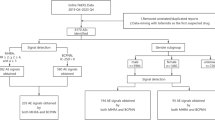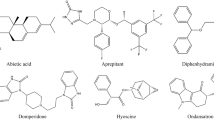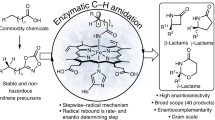Abstract
THE high affinity of chlorotetracycline (aureomycin) and oxytetracycline (terramycin) for the cations of heavy metals has been reported1. This investigation is now extended to the parent substance, tetracycline, with the results shown in Table 1, which also includes some new values for the substituted tetracyclines.
This is a preview of subscription content, access via your institution
Access options
Subscribe to this journal
Receive 51 print issues and online access
$199.00 per year
only $3.90 per issue
Buy this article
- Purchase on SpringerLink
- Instant access to full article PDF
Prices may be subject to local taxes which are calculated during checkout
Similar content being viewed by others
References
Albert, A., Nature, 172, 201 (1953).
Noyes, A., Z. physikal. Chem., 11, 495 (1893).
Albert, A., Biochem. J., 54, 646 (1953).
Albert, A., Biochem. J., 47, 531 (1950); 50, 690 (1952).
Albert, A., Rubbo, S. D., Goldacre, R. J., and Balfour, B., Brit. J. Exp. Path., 28, 69 (1947). Rubbo, S. D., Albert, A., and Gibson, M., ibid., 31, 425 (1950). Albert, A., Gibson, M., and Rubbo, S., ibid., 34, 119 (1953).
Albert, A., and Rees, C. W., Brit. Med. J., ii, 1027 (1955).
Author information
Authors and Affiliations
Rights and permissions
About this article
Cite this article
ALBERT, A., REES, C. Avidity of the Tetracyclines for the Cations of Metals. Nature 177, 433–434 (1956). https://doi.org/10.1038/177433a0
Issue date:
DOI: https://doi.org/10.1038/177433a0
This article is cited by
-
Drug delivery nanocarriers and recent advances ventured to improve therapeutic efficacy against osteosarcoma: an overview
Journal of the Egyptian National Cancer Institute (2021)
-
Joint toxicity of tetracycline with copper(II) and cadmium(II) to Vibrio fischeri: effect of complexation reaction
Ecotoxicology (2015)
-
Potentiometric studies on the complexes of tetracycline (TC) and oxytetracyclin (OTC) with some metal ions
Monatshefte f�r Chemie Chemical Monthly (1992)
-
Voltammetric studies on composition and stabilities of complexes of tetracycline and oxytetracycline with some metal ions in aqueous medium
Monatshefte für Chemie - Chemical Monthly (1992)
-
Inactivation of thiostrepton by copper(II)
Biology of Metals (1990)



